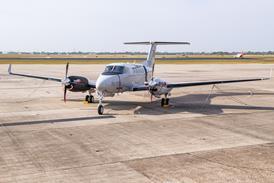US defence technology company Edo is pressure-testing a prototype composite engine-inlet duct.
The duct was manufactured using vacuum-assisted resin transfer moulding (CRTM) and a braiding process under the US Air Force’s Composite Affordability Initiative (CAI).
The inlet is undergoing “hammershock” tests that simulate the inlet shockwave’s pressure spike. The CAI programme seeks to reduce composite airframe structure costs. The complicated inlet shape was considered a manufacturing challenge, with the performance and quality goals to be met using the most affordable production process. The vacuum RTM process is already used for missile fuselages. The inlet was made by braiding, which is a circular weaving process using a large automated 35-segment mandrel. It was covered with five layers of carbonfibre with a honeycomb core, with inserts to stiffen the duct wall.
The honeycomb core was filled with closed-cell foam to ensure resin does not fill the cell walls. Reinforcing keel straps were added to the structure and an epoxy resin infused using the vacuum- assisted process. After curing, the internal mandrel segments were removed.
Source: Flight International




















